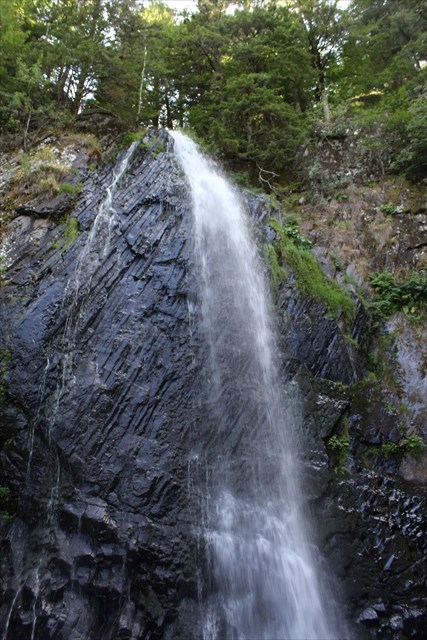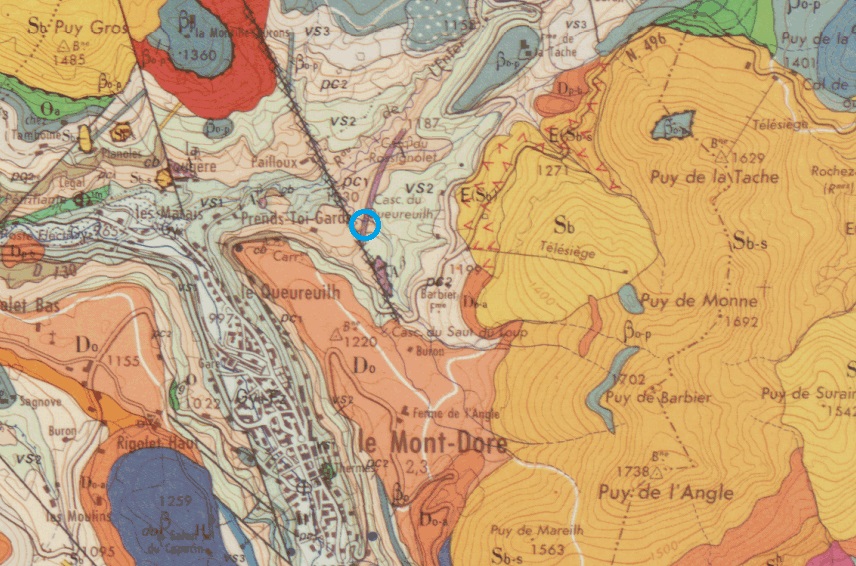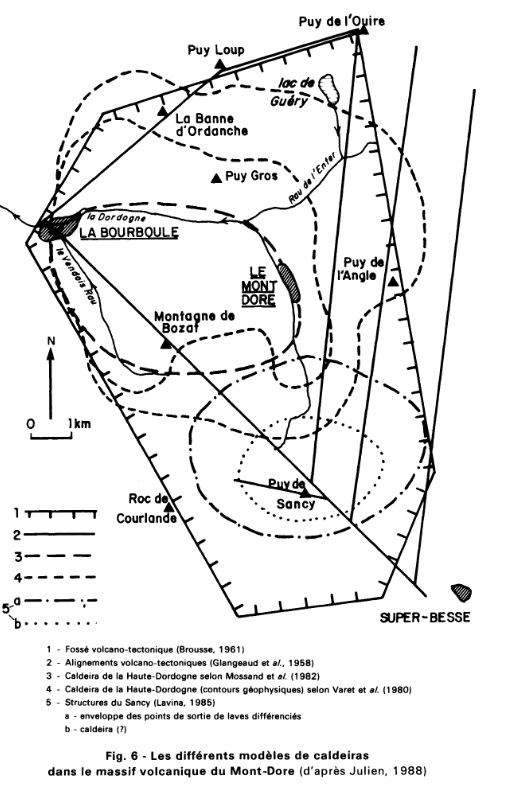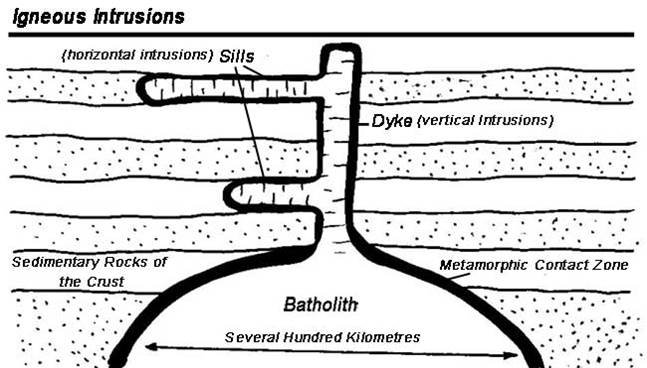Prismes Ankaramitiques de la cascade de Queureuilh

Vue des orgues derrière la cascade (source : perso)
1 – Contexte géologique Geological context
Le volcanisme des Monts Dore s’est exprimé entre -2,5 mA et -0,2 mA sur un socle granitique érodé, parcouru d’importantes fractures litosphériques hercyniennes activés lors des épisodes volcaniques du Miocène et du Pléistocène. La reconstitution de l’histoire géologique a été réalisée à l’aide es niveaux repères de ponce régionale.
En observant attentivement les calderas du massif, on note que la cascade de Queureuilh s’intègre parfaitement dans la nappe de ponce la plus représentative du secteur. Ces ponces, fibreuses à l’extérieur de la caldéra, brisées à l’intérieur, contient des quartz bipyramides associés à des clinopyroxènes verts, du zircon, du sphène et de la magnétite. Ces ponces sont issues de la différenciation du magma basaltique.
Une activité volcanique plus tardive a cependant permis une intrusion basaltique d’ankaramite. L’ankaramite est une formation à gros cristaux de pyroxène visibles et à petits cristaux d’olivine. Son origine ne provient pas d’une coulée mais provient d’un sill, c'est-à-dire d’un filon en forme de couche à l’intérieur d’une autre couche volcanique.
The volcanism of the Monts Dore ranged between -2.5 mA and -0.2 mA on an eroded granitic base, traversed by important Hercynian litospheric fractures activated during the Miocene and Pleistocene volcanic episodes. The reconstruction of the geological history was carried out using reference levels of regional pumice.
Observing carefully the massif calderas, we notice that the cascade of Queureuilh fits perfectly into the most representative pumice in this area. These fibrous pumices outside the caldera, broken inside, contain bipyramid quartz associated with green clinopyroxens, zircon, sphene and magnetite. These pumices are derived from the differentiation of basaltic magma.
Later volcanic activity, however, allowed a basaltic intrusion of ankaramite. Ankaramite is a formation with large crystals of visible pyroxene and small crystals of olivine. Its origin does not come from a casting but comes from a sill, that is to say from a vein with layer form inside another volcanic layer.

Carte géologique des environs de Mont Dore (BRGM)

Les calderas du Mont Dore.
2 – Origine des prismes Prisms origin.
Les prismes volcaniques sont toujours perpendiculaires au flux de lave. Ils sont donc horizontaux dans le cas d’un dyke (voir cascade du Rossignolet) et verticaux dans le cas d’un sill.
La formation hexagonale correspond à la répartition des déformations et au relâchement des contraintes de retrait. Le refroidissement des laves en bord de coulée doit être hétérogène tandis que le milieu doit être homogène (isotropie).Ainsi les contraintes se répartissent de façon homogène et le relâchement entraîne la fissuration.
La prismation peut se décomposer en trois fractions :
- La fausse colonnade en sommet de coulée
- L’entablement au cœur de la coulée
- La vraie colonnade en base de coulée.
The volcanic prisms are always perpendicular to the lava flow. Therefore, they are horizontal in the case of a dyke (see cascade of Rossignolet) and vertical in the case of a sill.
The hexagonal formation corresponds to the distribution of the deformations and to the relaxation of the shrinkage stresses. The lava cooling at the lava flow edge must be heterogeneous whereas the medium must be homogeneous (isotropy). Thus the stresses are distributed homogeneously and the relaxation leads to cracking.
Prismation can break down into three fractions:
- The false colonnade at the top of the lava flow,
- The entablature at the heart of the lava flow,
- The true colonnade in base of the lava flow.

Formation d’un Sill
3 - Questions Questions
Loguez cette cache "Found it" et envoyez-moi vos propositions de réponses aux 4 questions suivantes soit via mon profil, soit via la messagerie geocaching.com (Message Center), et je vous contacterai en cas de problème. Inclure au log une photo de vous (optionnel) devant la cascade sans toutefois donner des éléments de réponse.
You can log this cache "found it" and send me by e-mail or message center on geocaching.com your answer propositions to the 4 following questions. In case of problem, I will contact you back. Include a photo of you (optional) among the fossils or in front of the outcrop without revealing the answers.
|
a) Expliquez en quelques mots pourquoi les prismes ne sont pas perpendiculaires au sol.
Explain briefly why the prisms are not perpendicular to the ground.
b) Décrivez les colonnes derrière la cascade (couleur, toucher, présence de minéraux). Combien d’arêtes pouvez-vous compter sur ces colonnes ? WP 1.
Describe the columns behind the cascade (color, touch, presence of minerals). How many ridges can you count on these columns? WP 1
c) D’après vous, le sill à l’origine de cette formation d’ankaramite est-il antérieur ou postérieur à la ponce dominant le secteur ?
In your opinion, is the sill at the origin of this ankaramite formation anterior or posterior to the pumice dominating the sector?
d) Au WP 2, partiellement immergé, se trouve un élément géologique à l’horizontale. Quel est-il et quelles sont ses dimensions ?
At WP 2, there is a partially submerged geologic element in the horizontal. What is it and what are its dimensions?
|
4 - Bibliographie Bibliography
- Audubert, F. et al, La commission de volcanisme dans les monts Dore (2013)
http://www.saga-geol.asso.fr/Documents/Saga_329_Excursion_monts_Dore_1.pdf
- Brousse, R. et al, notice explicative de la feuille Bourg-Lastic à 1/50000 (1989)
http://ficheinfoterre.brgm.fr/Notices/0716N.pdf
-Legros, J.-P., Nicolas, A., Le volcanisme du massif central, Académie des Sciences et Lettres de Montpellier (2008)
http://www.ac-sciences-lettres-montpellier.fr/academie_edition/fichiers_conf/LE%20VOLCANISME.pdf
-Nehlig, P. et al. Les volcans du massif central, BRGM (2003)
http://www2.brgm.fr/volcan/papgeologue.pdf
